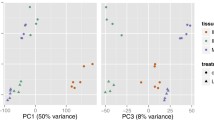Abstract
Objective
To evaluate the heat shock protein (HSP) variation during the differentiation and polarization of human macrophages.
Methods
Gene expression analysis was investigated by real-time PCR from mRNA of human monocytes obtained from the buffy coats of healthy volunteers, polarized to classically activated macrophages (or M1), whose prototypical activating stimuli are interferon-gamma and lipopolysaccharide, and alternatively activated macrophages (or M2) obtained by interleukin-4 exposure. The modulation of HSPs at the transcriptomic levels was investigated using oligonucleotide microarray in the process of primary human monocyte-to-macrophage maturation and subsequent polarization into M1 or M2 cells.
Results
We found that 11 HSPs transcripts were modulated throughout monocyte-to-macrophage differentiation. Furthermore a considerable effect on HSP expression was detected in conjunction with the M1 polarizing condition. This affected 21 transcripts in M1 cells, with 6 of them significantly upregulated in comparison to unpolarized macrophages, whereas 15 were downregulated. Slight changes in HSPs expression were observed in M2 cells when compared to unpolarized macrophages. Under these circumstances only five transcripts were significantly modulated. Interestingly, HSPBAP1 was the only HSP significantly downregulated in both M1 and M2 conditions parallel to a significant up-regulation of its target HSPB1.
Conclusion
Our study revealed that monocytes undergoing maturation differentially regulate the expression of several members of HSPs and that distinct patterns of HSP expression characterize the M1 and M2 effector stages of macrophage life.



Similar content being viewed by others
References
Robert J. Evolution of heat shock protein and immunity. Dev Comp Immunol. 2003;27:449–64.
Srivastava P. Interaction of heat shock proteins with peptides and antigen presenting cells: chaperoning of the innate and adaptive immune responses. Annu Rev Immunol. 2002;20:395–425.
Javid B, MacAry PA, Lehner PJ. Structure and function: heat shock proteins and adaptive immunity. J Immunol. 2007;179:2035–40.
Bensuade O, Babinet C, Morange M, Jacob F. Heat shock proteins, first major products of zygomatic activity in mouse embryo. Nature. 1983;305:331–2.
Krowczyk Z, Szymik N, Wisniewski J. Expression of hsp7o-related gene in developing and degenerating rat testis. Mol Bio Rep. 1987;12:35–41.
Wu BJ, Morimoto RJ. Transcription of the human hsp7o gene is induced by serum stimulation. Proc Natl Acad Sci USA. 1985;82:6070–4.
de Thonel A, Vandekerckhove J, Lanneau D, Selvakumar S, Courtois G, Hazoume A, et al. HSP27 controls GATA-1 protein level during erythroid cell differentiation. Blood. 2010;116:85–96.
Martin CA, Kurkowski DL, Valentino AM, Santiago-Schwarz F. Increased intracellular, cell surface, and secreted inducible heat shock protein 70 responses are triggered during the monocyte to dendritic cell (DC) transition by cytokines independently of heat stress and infection and may positively regulate DC growth. J Immunol. 2009;183:388–99.
Granelli-Piperno A, Andrus L, Steinman RM. Lymphokine and non lymphokine mRNA levels in stimulated human T cells. J Exp Med. 1986;163:922–37.
Haire RN, Peterson MS, O’Leary JJ. Mitogen activation induces the enhanced synthesis of two heat-shock proteins in human lymphocytes. J Cell Biol. 1988;106:883–91.
Twomey BM, McCallum S, Isenberg DA, Latchman DS. Elevation of heat shock protein synthesis and hsp gene transcription during monocyte to macrophage differentiation of U937 cells. Clin Exp Immunol. 1993;93:178–83.
Loones MT, Morange M. Hsp and chaperone distribution during endochondral bone development in mouse embryo. Cell Stress Chaperones. 1998;3:237–44.
Ishiwatari S, Suzuki T, Hitomi T, Yoshino T, Matsukuma S, Tsuji T. Effects of methyl paraben on skin keratinocytes. J Appl Toxicol. 2007;27:1–9.
Ito H, Kamei K, Iwamoto I, Inaguma Y, Kato K. Regulation of the levels of small heat-shock proteins during differentiation of C2C12 cells. Exp Cell Res. 2001;266:213–21.
Ribeil JA, Zermati Y, Vandekerckhove J, Cathelin S, Kersual J, Dussiot M, Coulon S, Moura IC, Zeuner A, Kirkegaard-Sorensen T, Varet B, Solary E, Garrido C, Hermine O. Hsp70 regulates erythropoiesis by preventing caspase-3-mediated cleavage of GATA-1. Nature. 2007;445:102–5.
Lanneau D, de Thonel A, Maurel S, Didelot C, Garrido C. Apoptosis versus cell differentiation: role of heat shock proteins HSP90, HSP70 and HSP27. Prion. 2007;1:53–60.
Srivastava PK, Menoret A, Basu S, Binde RJ, McQuade KL. Heat shock proteins come of age: primitive functions acquire new roles in an adaptive world. Immunity. 1998;8:657–65.
Botzler C, Issels R, Multhoff G. Heat-shock protein 72 cell-surface expression on human lung carcinoma cells in associated with an increased sensitivity to lysis mediated by adherent natural killer cells. Cancer Immunol Immunother. 1996;43:226–30.
Randow F, Seed B. Endoplasmic reticulum chaperone gp96 is required for innate immunity but not cell viability. Nat Cell Biol. 2001;3:891–6.
Kostenko S, Moens U. Heat shock protein 27 phosphorylation: kinases, phosphatases, functions and pathology. Cell Mol Life Sci. 2009;66:3289–307.
Acknowledgments
We thank Dr. Filomena Biazzo of the S.Immuno-Haemathology and Transfusional Medicine, and Dr. Michele Tuttobene for the preparations of buffy coats.
Author information
Authors and Affiliations
Corresponding author
Additional information
Responsible Editor: Michael Parnham.
Electronic supplementary material
Below is the link to the electronic supplementary material.
Rights and permissions
About this article
Cite this article
Fagone, P., Di Rosa, M., Palumbo, M. et al. Modulation of heat shock proteins during macrophage differentiation. Inflamm. Res. 61, 1131–1139 (2012). https://doi.org/10.1007/s00011-012-0506-y
Received:
Revised:
Accepted:
Published:
Issue Date:
DOI: https://doi.org/10.1007/s00011-012-0506-y




